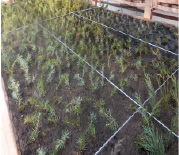In urban plantings arid region of conifers species insignificantly are used in landscaping [1, 2, 3]. In the collections of State Scientific Institution All-Russian Scientific and Research Institute of Agroforestry and of Nizhnevolzhskaya Woody Species Selection Station along with our aborigine Juniperus sabina L. one can also find Juniperus virginiana L. and Juniperus communis L., as well as their forms of various age (see the table).
Juniperus propagates by seeds, propagules, offshoots (creeping forms), it looks beautiful in groups and in underwood of thin forests of birch and larch. It is a drought-resistant and light-demanding plant. Plantation using J. sabina produces a high water-protective, soil-protective, sanitary and hygienic effect. The experience of introducing J. virginiana (North American species) shows that the species grows fairly good in dry climate of Volgograd region and reaches 6 m, J. communis reaching 3.5 m. Despite its good vegetation J. virginiana so far has not been widely used and has not taken a rightful place in the variety of green woodlands of settlements in Volgograd region (picture 1).
Under the conditions of light-chestnut and chestnut soils of Volgograd region Juniperus virginiana begins to fruit from 6-7 years of age and produces up to 70 per cent of good-quality seeds, the index of good quality in seeds of J. communis being low (25 to 45 percent).
As the research has shown, when propagated by seeds J. virginiana grows rather fast compared to other species. In the first vegetation year its seedlings reach 10-12 cm, in the second year they reach 20-25 cm, 4-year old plants are 65-80 cm high, as for 5-6-year old plants, they are already suitable for planting permanently (picture 2).
Ecological and Biological Characteristics of Junipers L Species under the Conditions of Light-Chestnut Soils (aged 25)
|
Species Juniperus L. |
Height, m |
Winter hardness* |
Drought hardness |
Blossoming |
Fruiting |
|
J. virginiana L |
5.3 – 6.0 |
5 |
5 |
5 |
4 |
|
J. sabina L. |
0.4 – 0.5 |
5 |
5 |
2 |
2 |
|
J. communis L. |
2.8 – 3.5 |
5 |
5 |
3 |
3 |
*in points, 5 – excellent, 4 – good, 3 – satisfactory, 2 – poor.



Picture 1. Application of species Juniperus in landscaping (Kamyshin, Volgograd region)


Picture 2. Experiment on the vegetative reproduction Juniperus
Thus, J. virginiana is one of the promising coniferous plants for landscaping under arid conditions; it has various crown shapes and needle colors. Juniper is tolerant to artificial shaping of the crown. J. virginiana can grow on various soils, including slightly salinated ones. The experience of using J. virginiana in the greeneries of Kamyshin showed, that juniper is relatively resistant under the conditions of air dustiness and air pollution in urban areas, in group greeneries it tolerates shading.
Библиографическая ссылка
Ulyanov D.V., Semenyutina A.V. OPTIMIZATION OF GREEN PLANTINGS URBANIZED OF LANDSCAPES SPECIES OF JUNIPERUS L. // Международный студенческий научный вестник. 2015. № 2-3. ;URL: https://eduherald.ru/ru/article/view?id=12325 (дата обращения: 03.04.2025).

